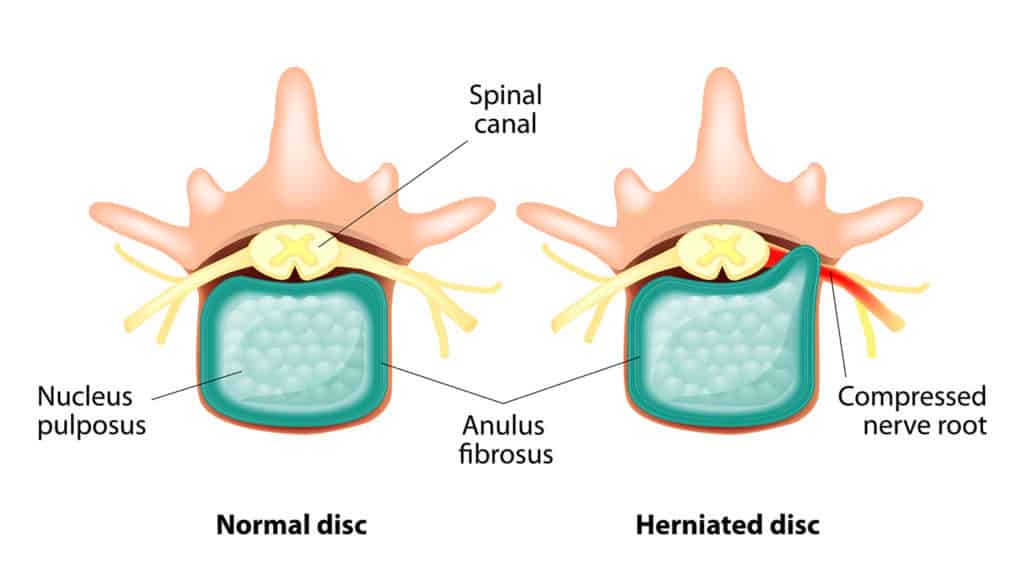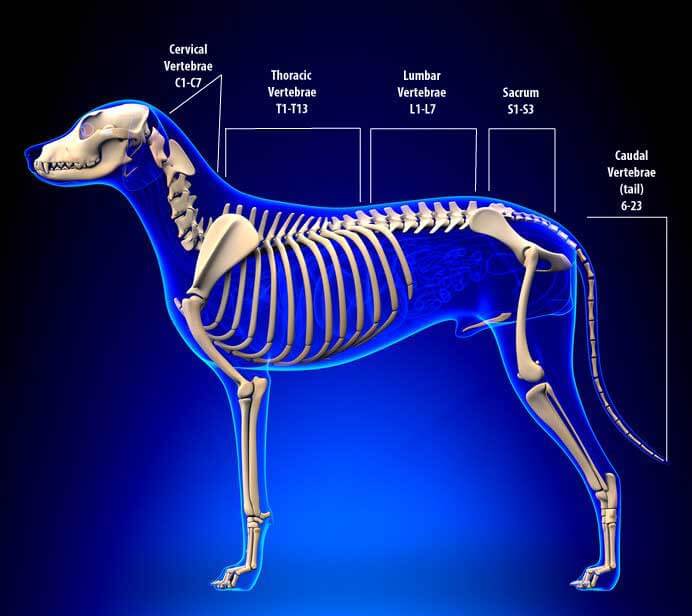
Spine problems often arise throughout most French bulldogs’ lifetime. The existence of many spine diseases, e.g., hemivertebrae, degenerative myelopathy, and slipped disc disease, makes understanding each of them very important, particularly as an owner.
Intervertebral disc disease (IVDD) is common in French bulldogs. As the name suggests, it affects the intervertebral disc.
In French Bulldogs IVDD can occur in two ways. Trauma that results in the rapture of a healthy disc, and aging causes the deterioration of the disc. The condition ranges from mild pain to severe and can even in the worst cases, cause paralysis.
Thus, being able to spot some of the symptoms early and ensuring it receives the much-needed care and treatment will reduce the potential suffering.But first, what is the intervertebral disc, and what is the intervertebral disc disease (IVDD)?
Intervertebral Disc
All mammals (and other animals) have a spine that provides structural support, protects the spinal cord, and enables motion.
The spine is a collection of bones called vertebrae, through which the spinal cord passes. To create a robust structural component (the spine), the individual vertebrae are be linked together using intervertebral discs.
Intervertebral discs are spongy pads that connect one vertebra to another. They are shock absorbers – thereby acting as a cushion – giving strength to the spine, and promoting its flexibility.
It also prevents the vertebrae from rubbing against each other, which could result in wearing out.
The disc is round with a hole at the center, through which the spinal cord passes. Structurally, a disc comprises an outer tough fibrous layer, known as annulus fibrosus, that covers the nucleus pulposus, which is semi-fluid.
Unlimited claims, No credit checks, No upper age limit & Multiple pet discounts
Compare the best rates on pet insurance
What is Intervertebral disc disease in French Bulldogs?
IVDD occurs when the intervertebral disc(s) herniate(s). Disc herniation simply refers to the bursting or bulging of the discs, as seen in figure 1.

As stated above, the IVDD can occur due to trauma or degeneration.
Trauma
When a French bulldog falls from an elevated position or is hit by a vehicle, it experiences trauma. Such accidents rapture or tear the annulus fibrosus causing the nucleus pulposus to flow out.
The intervertebral disc surrounds the spinal cord, and once it has ruptured, the released semi-liquid exerts significant pressure on the spinal cord leading to pain. This is a form of slipped disc disease resulting from compression.
Alternatively, the rapturing may occur in the area surrounding the spinal cord, thereby bruising it. This is a form of slipped disc resulting from concussion.
When the damage occurs in any of these two ways, your French bulldog will be said to have slipped disc disease.
Degeneration
French bulldogs are a chondrodystrophic breed. Chondrodystrophic dogs are those that have short legs. This condition is ingrained in the dogs’ genes and is biologically known as chondrodysplasia or chondrodystrophy.
The chondrodysplasia phenotype causes these dogs to be born with abnormal cartilages. It also affects these dogs’ growth plates.
Being a chondrodystrophic breed, French bulldogs are genetically predisposed to the degeneration of the intervertebral disc. This deterioration can occur in two ways:
- The upper part of the annulus fibrosus thickens progressively due to calcification and continuous stress. The thickening, which happens due to aging, causes this fibrous layer to press against the spinal cord.
- The nucleus pulposus becomes dry with each passing day, thereby inhibiting the disc from absorbing shock or sudden impact. The drying up causes the fibrous layer to tear, and the nucleus, which is now borderline solid, bulges out and exerts pressure on the spinal cord.
This second way is the most common cause of IVDD in French Bulldogs because they naturally have abnormal cartilages and short legs.
Additionally, the first is a rare possibility because Frenchies aren’t a hyperactive breed. But you shouldn’t rule it out.
Granted, Frenchies are predisposed to IVDD, but how do you know that your pet has the disease?
How to know if your French Bulldog has a slipped disc
Your Frenchie can develop a slipped disc at any age. However, as it ages, more and more factors that could trigger the disease come up. As such, older French bulldogs are particularly vulnerable.
Regardless of age, you can know whether your French bulldog has IVDD if it has the following symptoms.
Symptoms
- Signs of pain, including moaning or crying, refusing to jump when commanded, and being sensitive to touch when you offer to pet it
- Difficulty or abnormal walking, particularly using the hind legs (uncoordinated leg movement)
- Difficulty standing up from a sleeping position
- Inability to stand or walk for long
- Loss of sensitivity in the hind legs
- Tense neck muscles
- Trembling or muscle spasms
- Hunched back
- Reduced physical activity compared to previous times due to general body weakness
- Lack of control of defecation or urination
- Paralysis (in rare cases)
You should note that some of these symptoms vary depending on the area within the spine where the intervertebral disc has ruptured or torn. If the region is around the neck area, its front and hind legs will be uncoordinated.
If the affected area is around the mid-back. In that case, you’ll notice the hunched back and the inability to walk or stand using the hind legs.
Diagnosis
If you’ve observed some or even all of these symptoms, immediately take your French bulldog to a vet for diagnosis.
The vet will first undertake a blood test. The blood test doesn’t diagnose slipped disc disease. Instead, it’ll rule out any other possible cause of back problems. For instance, the presence of bacteria could indicate the existence of an infection.
The vet will then undertake a thorough neurological exam that includes x rays, MRI, or a CT scan. The latter two are mainly used to locate the exact areas where the disc has pinched or bruised the spinal cord before scheduling surgery to repair the damage.
X rays are the primary test your vet will use. However, it won’t be the normal x rays that you’re used to.
The procedure first entails administering anesthesia and then injecting a dye into the region surrounding the spinal cord. This will make the area visible on the x-ray images. This type of x rays tests are known as myelography.
The severity of IVDD Symptoms
The IVDD symptoms are categorized into 5 groups. The categorization helps vets choose the most ideal treatment.
Additionally, as the owner, knowing such information will keep you in the know about what to expect when you visit your vet.
Grade 1
Your French bulldog will have a normal posture and will also walk or run normally. However, it’ll be in pain, although its neurological system won’t have been affected at this stage.
Grade 2
Your French bulldog will be in pain and will also have a mild deficiency with regards to its response to stimuli. You’ll notice some delayed reactions.
Grade 3
Your French bulldog will have moderate deficits when it comes to its response to stimuli. You’ll notice this through its uncoordinated movement or when it crosses its hind legs while standing. It will also exhibit signs of pain.
Grade 4
You’ll notice severe neurological deficits. For instance, your French bulldog won’t be able to walk, but it will still be in a position to move its legs.
The pain it will be under will be very noticeable, particularly when you touch it. At this stage, it won’t even be feeling your touch.
Grade 5
This is the final grade, which is synonymous with paralysis. Your dog will no longer possess the ability to move its limbs.
It won’t be able to control defecation and urination or move its limb once you clamp or pinch its toe or tail firmly in what we refer to as deep pain reflex.
How to know the seriousness of slipped disc in your French bulldog
Healthy dogs have deep pain reflex. This makes clamping its tail or toe an ideal method of identifying the extent of the IVDD.
However, testing for the deep pain reflex should be the last resort since it’s very uncomfortable and painful for a healthy dog. It should only be carried out by a vet when they notice that your French bulldog is incapable of even the slightest voluntary movement.
The severity of slipped disc increases from grade 1 to grade 5. As such, you’ll know that the IVDD is at a severe stage when your Frenchie can no longer walk but can move its limbs. And even more severe when it can’t make even the slightest voluntary movement of its limbs.
Treatment and Recovery
Non-surgical treatment
Non-surgical treatment is preferred under the following circumstances:
- Your French bulldog has minimal spinal cord damage: When the neurological tests reveal that the symptoms above are the result of spinal bruising, then there’s no need for surgery.
- Your French bulldog has never experienced back pain before.
- Your French bulldog suffers from a medical condition that renders anesthesia unusable (contraindication), e.g., diabetes mellitus and liver, heart, or kidney disease. Using anesthesia when your Frenchie has one or all of these conditions may give rise to other complications.
Non-surgical interventions for IVDD include laser therapy, forced cage rest, and administering drugs that reduce inflammation and pain.
Laser therapy is particularly effective if:
- The slipped disc is in the mid-back region (between the T3 and L3 vertebrae) as seen in figure 1.
- Your French bulldog exhibits mild to moderate deficits (grade 2 and 3). The signs to look out for include uncoordinated walking, dragging one or more legs, and weakness or pain on the hind legs.
- Your French bulldog still has the deep pain reflex.

Forced crate rest entails locking your Frenchie in a cage, given its small size, for at least 4 weeks. It’s often used together with pain and inflammation drugs.
However, the vet should see the dog regularly to gauge the progress of the treatment and determine whether your French Bulldog requires surgery.
However, forced crate rest is likely to lead to depression. It is, therefore, crucial to be there for your Frenchie throughout.
Surgical treatment
Surgical treatment is the go-to treatment for most intervertebral disc disease cases. It entails drilling a hole in the vertebrae whose intervertebral disc has slipped to remove the disc section pressing against the spinal cord. After the surgery, your Frenchie will recover after 1 to 4 weeks.
The surgery is risky since it has the potential to cause more trauma. However, it’s the most preferred treatment method because it prevents further degeneration of the disc once completed successfully.
Furthermore, the success depends on the extent to which the pressure had impacted the spinal cord’s function. The longer your French bulldog stays with no pain sensation in its legs, the less likely the surgery will bring it back to normal.
In such cases, the likelihood of recovery to the point where your Frenchie regains the ability to walk is between 20% and 50%. Besides the low chances of success, another disadvantage of surgery is the cost.
French bulldog spine surgery cost
The French bulldog spine surgery cost is pretty hefty. The figure is around $9000 without factoring in the charges for the neurological tests, which range from $1000 to $3000.
Therefore, the total cost of diagnosing and treating IVDD in French bulldogs (through surgery) is about $12000. As such, we advise that you get pet insurance if you don’t have a policy already. It will save you a lot.
How to Prevent IVDD in French Bulldogs
Given that part of the problem is the breed’s genetics, it may be impossible to completely prevent intervertebral disc disease in French bulldogs.
However, you can use the following interventions to prevent IVDD caused by trauma:
- Keep your French bulldog’s weight in check. Your pet shouldn’t be obese.
- Have a moderate exercise regimen for your Frenchie. This will prevent stress on the joints and also help you control its weight. Always know that overexertion is bound to cause spinal cord injury and an expensive injury at that.
- Feed your French bulldog a healthy diet. Its food and treats should contain nutrients that’ll ensure it has healthy and strong joints.
Can Intervertebral Disc Disease Reoccur in French bulldogs?
If your French bulldog once had a slipped disc but recovered, you should still employ these preventive measures.
Because intervertebral disk disease can reoccur. A 2004 study showed that 19.2% of dogs that previously had IVDD redeveloped. 96% of these cases were among those dogs that had undergone surgery.
Although the study’s dataset also included other chondrodystrophic breeds, the results conclusively show that your Frenchie can develop IVDD again.
Conclusion
A thorough diagnosis of this disease is crucial. Only then can vets begin to offer the most appropriate treatments, which include surgery in rare cases where the disc has severely damaged parts of the spinal cord.
Pet parents should note that IVDD is not an end-all health issue for their breed. You can still live a very healthy lifestyle with your dog.
Additionally, IVDD is manageable to an extent. However, it’s crucial that French bulldog owners know the symptoms and understand the nature of this disease so they can act immediately in case the problem arises.
Unlimited claims, No credit checks, No upper age limit & Multiple pet discounts
